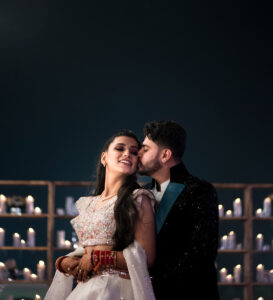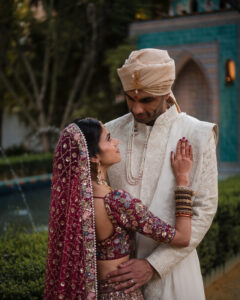Dia Dhuit!
Happy St Patrick’s Day Fairies. We hope you’re all decked out in green, searching for four-leaf clovers whilst snacking on shellfish today.
In honour of St Patrick’s Day, and for all our soon-to-be newlyweds, these Irish wedding traditions are both fun and meaningful ways to celebrate the Irish culture. Though some of these traditions have faded over the years, it’s still possible to incorporate elements of them into your wedding. So get scrolling and learn how to honour your Irish heritage on your special day.
Aitin’ The Gander
Right before the wedding, the groom would be invited to the bride’s house to enjoy a meal of cooked goose, which would be cooked in his honour. In older times, Aitin’ the Gander would be the time when marriage contracts were signed and once the feast was eaten, the groom would not be able to change his mind about the marriage. This is also where the Irish get the expression, “his goose is cooked.”
Wearing A Blue Wedding Dress
Not one for a white dress? While white is mostly used to represent purity, blue was originally seen as the symbol of virginity and was widely worn by Irish brides.
https://www.instagram.com/p/Buo6BLcHd7D/
Locking The Church Doors On The Groom
We’re sure you have no doubt of your groom’s love for you, but apparently, some Irishmen back in the day put some doubts in their bride’s heads. As men were thought to get cold feet often, guests would lock the Church door after the couple entered to prevent the nervous groom from rushing off.
Women Can Propose On The Leap Year
Just like that so-bad-it’s-good rom com, Leap Year, the tradition says that only on the leap day of the leap year can a woman propose to a man. According to legend, it had to do with a young woman who was upset that the men she liked were too shy to ask for her hand in marriage. Because of this, St. Patrick gave her his blessing so that women could propose on this one day.
Wearing Wildflowers In Braided Hair
It is a tradition for the bride to wear her hair long and braided as a symbol of feminine power. Further, a crown of wildflowers would also be worn, but cannot be put on by the bride herself as that was considered bad luck. Wildflowers could also be handpicked for bouquets.
https://www.instagram.com/p/BuqTu-NnyfC/
Marrying During Shrovetide
According to an old Irish folk rhyme:
Monday for wealth,
Tuesday for health,
Wednesday the best day of all,
Thursday for losses,
Friday for crosses,
And Saturday no luck at all.
However, during the 40 days of Lent, no weddings could take place, which is why Shrove Tuesday (the day before Lent) became a popular day to get married.
Exchanging Claddagh Rings
Originating from the fishing village of Claddagh near Galway, and generally passed down from mother to daughter, the rings are a symbol of love, marriage, and also friendship. Depending on how it is worn, a heart facing away from the girl wearing it means she is single, while a heart facing her means she is taken.
https://www.instagram.com/p/Bp9KmFqgDfR/
Sixpence In The Shoe
The sixpence was meant to act as a good luck charm and a way to ward off evil spirits. In older times, men would give the coin to their bride and she would place it inside her shoe. Other origins suggest that placing it in the bride’s left shoe symbolised wealth, joy, and financial gain.
Carrying A Horseshoe For Luck
Today, horseshoes still carry the connotation of being good luck charms. This originates in Celtic tradition, where they were often hung over doors and gave luck to newlyweds. Other traditions call for the horseshoe to be included in the bride’s jewellery, sewed onto her gown, or in her flower bouquet as she walks down the aisle with her father. The horseshoe must be facing upwards so that the luck doesn’t fall out.
https://www.instagram.com/p/BusHyFRHBrq/
Handfasting or ‘Tying The Knot’
This is where we get the phrase, “tying the knot.” In old Celtic tradition, a couple’s hands were bound together by a druid using a ribbon to symbolise their union. The correct way to do this is to join the right hand with the other person’s right hand, and the left hand with their left hand, then wrapping the ribbon over the crossed wrists and hands.
https://www.instagram.com/p/BXFOBHyHUko/
Ringing The Wedding Bells
Like many other traditions, the ringing of the wedding bells was seen as a way to get rid of evil spirits on the wedding day. The bells, on a smaller scale, can also be used by guests to as wedding gifts and by couples in their stationery and décor.
https://www.instagram.com/p/BkKyC-2BKHa/
Cover Photo By: @aliandlaura
Written By Chante El-Zoghbi



